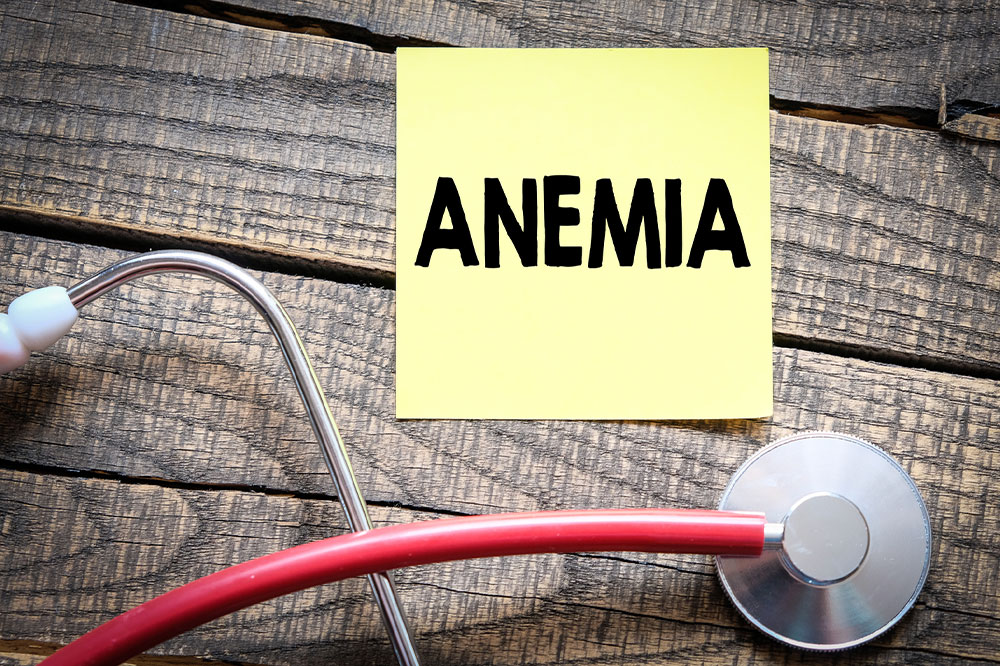Anemia – Symptoms, Types, and More
Anemia is a condition wherein a person has insufficient healthy red blood cells to transport oxygen to the body’s tissues. A protein called hemoglobin binds with oxygen molecules to carry it to other organs and tissues. However, the organs of an anemic person fail to receive this oxygen due to a low amount of healthy red blood cells. This is why anemia patients tend to feel more tired or cold.

What is low iron anemia?
If the concentration of iron is low in the body, it is not able to produce enough hemoglobin. Anemia caused in such instances is known as iron deficiency anemia. The common signs and symptoms of low iron anemia are weakness, tiredness, shortness of breath, angular cheilitis that is fissured at the corner of the mouth, a “fiery red” tongue, spoon-shaped and brittle nails, poor appetite, among others. The most common way to deal with iron deficiency anemia is to increase the concentration of iron in the body. This can be done by eating iron-rich foods and taking supplements, if needed.
Signs and symptoms
In most cases, the signs of anemia in women are the same as those in men. The condition can also occur during pregnancy. During pregnancy, there is an increase in the volume of blood, which also leads to an increased amount of iron needed by the body. This is to provide for the developing fetus. More blood and a higher amount of nutrients are needed. To maintain the oxygen level in the blood, higher amounts of iron and vitamin A need to be eaten. If a woman fails to do this, she can suffer from iron deficiency anemia.
Further signs of anemia in women include lethargy, body pain, back pain, dizziness, nausea, tachycardia, loss of concentration, among others. Women with this condition should have vitamin-rich foods during pregnancy. Supplements like vitamin A, folic acid, vitamin B12, vitamin B3, vitamin D, calcium, and iron are recommended.
How is anemia treated?
Anemia can be caused due to various underlying factors. To treat the disease, it is important to identify its cause. The causes can be identified by certain tests like a complete blood count (CBC). With the help of a CBC, the doctor can analyze the amount of hemoglobin present in the blood. If the amount is adequate, then the shape and size of hemoglobin molecules are checked. If a person gets diagnosed with anemia, the doctor will tell them to undergo further tests. In some instances, assessing a sample of the bone marrow for further diagnosis will be necessary.
Listed below are some types of anemia, along with their treatment methods.
Vitamin deficiency anemia
An insufficient amount of vitamins like B12, C, and folate can result in vitamin deficiency anemia. Eating foods that are rich in these minerals can be one way to manage the condition. Doctors also suggest taking vitamin supplements to fulfill the daily intake.
Iron deficiency anemia
Iron supplements are the most common method to manage this type of anemia. The supplements help restore iron levels in the body when a person is unable to absorb enough iron from their meals.
Aplastic anemia
This is a rare blood disorder. The treatment options for aplastic anemia can vary between blood transfusion and bone marrow transplant, depending on the severity of the symptoms.
Hemolytic anemia
It is a blood disorder wherein a person’s red blood cells destruct or die faster than the body can replace them with new cells. This condition can be managed via blood transfusions, surgery, blood and marrow stem cell transplants, and certain lifestyle changes.
Sickle cell anemia
This is a type of a blood disorder that is known as sickle cell disease. Here, the red blood cells’ shape changes to sticky sickle cells that can restrict blood flow. Stem cell transplant is known to be the only way to treat sickle cell anemia.
Foods to manage anemia
Green leafy vegetables
Green vegetables are excellent sources of nonheme iron. Moreover, coriander and spinach are rich in vitamin A. Other vegetables that can be included in one’s daily meals include collard greens, Swiss chard, and dandelion greens. They are rich in folate, and can be beneficial for those with vitamin deficiency anemia.
Legumes and pulses
Legumes like sprouts, chickpeas, and red kidney beans are known to have iron content. Beans and peas are ideal sources of folate, fiber, and complex carbohydrates.
Meat
Red meat, venison, and lamb are top sources of heme iron. Combining these foods with nonheme iron foods like green vegetables can improve iron absorption.
Nuts
People with anemia must eat nuts and seeds whenever they can. These are great sources of iron. Besides, they taste great on their own and can give a person the energy they need during the day. Raw pumpkin seeds, cashews, raw pine nuts, almonds, pistachios, sunflower seeds are some popular choices.